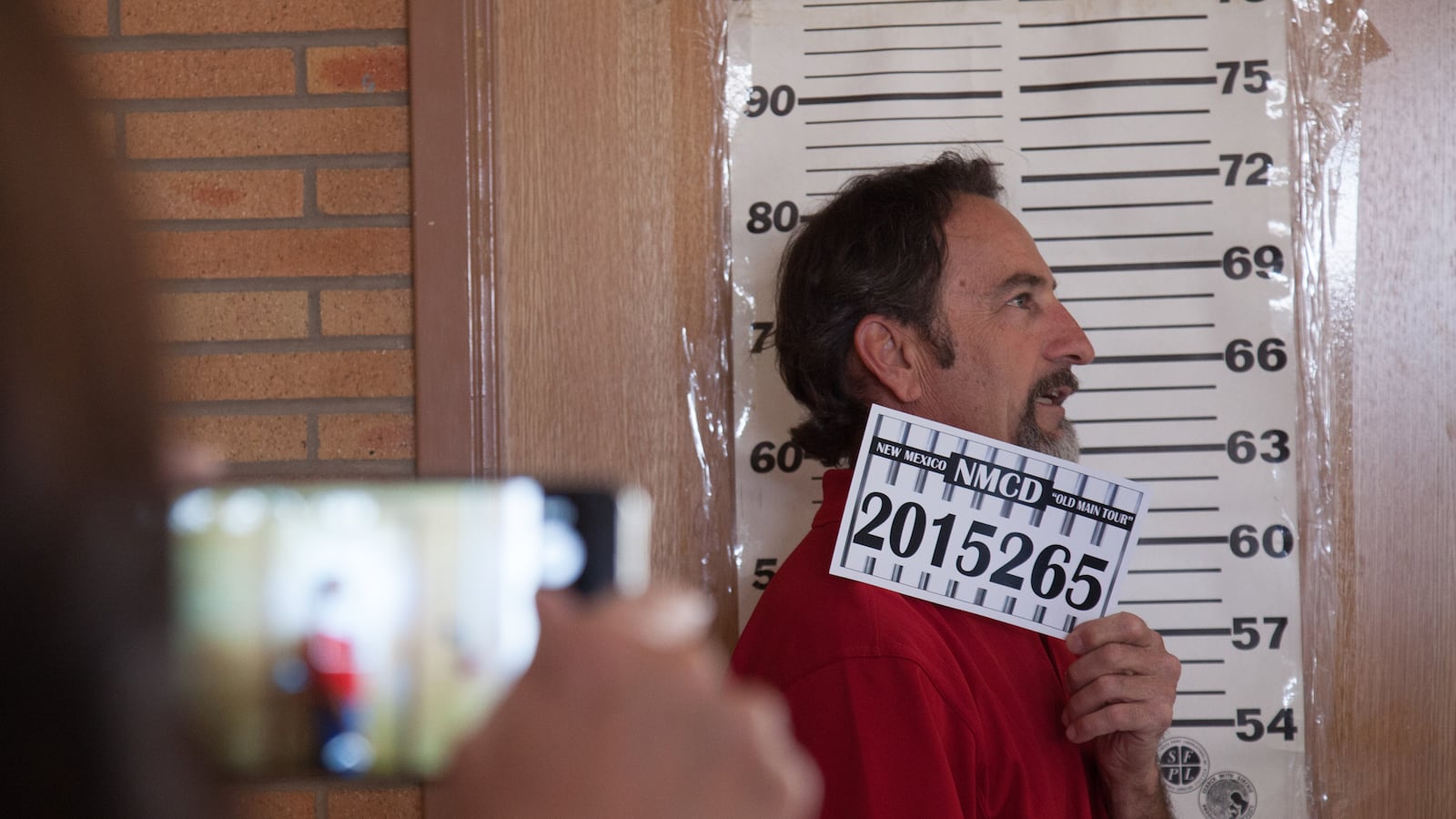The tour group looked at the hatchet marks, still visible today on the concrete floor.
“These were the inmates that fared the worse,” corrections officer and tour guide Trinidad Torres told us, pointing to the marred grooves, while 15 engrossed tour members listened intently.
We were in cell block 4 of the “Old Main” Penitentiary of New Mexico (PNM), where in 1980 one of the most violent prison riots in American history erupted.
In this part of the prison, 13 men were murdered, some tortured and dismembered; the hatchet marks are from one brutal beheading.
“Imagine what it would take to cut through the bone and into the concrete,” said Torres, who provides monthly tours at the “Old Main,” allowing curious civilians the opportunity to relive one of the darkest moments in United States penal history.
On February 2, 1980, a group of inmates drunk on homemade hooch, high on prescription drugs and armed with power tools, hatchets, and blowtorches, took over the PNM and began a 36-hour rampage of rape, torture, and murder.
“Think zombie apocalypse,” said former inmate Gary Nelson, describing to The Daily Beast the scene at the prison after inmates had taken control of the institution, gaining access to the contents of the pharmacy as well as power tools left by construction workers.
“The hallways of the prison were filled with acrid black smoke from the fires,” said Nelson. “You had all these high, angry, and armed inmates stumbling around. It was unreal.”
Thirty-six hours later, when the smoke had cleared and the National Guard regained control, 33 inmates had been killed by other prisoners—some tortured, mutilated, and dismembered; 12 guards were taken hostage and more than 100 individuals suffered serious injuries and overdoses, according to the official Attorney General report titled “The Penitentiary, The Riot, The Aftermath.”
The riot, unmatched in terms of its brutality and chaos, shocked the world and led to a nationwide conversation about conditions and treatment of prisoners in US prisons.
“The question isn’t why did this happen,” said Richard Moore, co-founder of the Chicano activist group the Black Berets that had been documenting the violence and abuses at PNM throughout the ’70s. “The question is why didn’t this happen earlier?”
The Attorney General’s report concluded that the riot stemmed from the poor conditions, severe overcrowding, inmate mistreatment, and a sinister “snitch game” of coercing inmates to inform on one another.
According to the report, “The snitch game is a system that uses the threat of disciplinary action to obtain information.”
Officer testimony to the Attorney General showed how “officers would sometimes put a snitch jacket on a prisoner just because they didn’t like them…to get even,” the report stated.
“There were staff members and supervisors that did not use the snitch information confidentially,” the report said, concluding that “the conduct of investigations within the penitentiary often made it obvious exactly who had informed on whom.”
This system, lacking any anonymity and often used for nefarious reasons, would fuel the most grotesque violence in cell block four, the protective custody unit where known “snitches” were held.
“This is part of New Mexico history,” said Brittany Gomez, a Santa Fe resident who has toured the defunct prison three times since its opening to the public. “It is important that we see it.”
The “Old Main Tours” began in 2012, created by the New Mexico Corrections Department (NMCD) as their contribution to the state's centennial celebration.
“Many think there is not much to celebrate about prisons,” said Alex Tomlin, the NMCD’s public affairs director. “But this is something we thought might be interesting to people.”

What began as a haphazard self-guided tour has since evolved into a organized experience, complete with historical pamphlets, a gift shop with inmate-made Virgin of Guadalupe T-shirts, teddy bears, whittled animals, and a unique paper booking card for your own personalized mug shot.
“Let's hope this is the only time you see me like this,” said one tour member, joking to his partner as he posed for the mug shot.
The tour begins with a NMCD film, narrated by cheerful officers who speak to the wonders of the New Mexico prison system.
Statements like “changing hearts and minds” and “respecting our past to create a better future” set the tone for a tour of the department’s biggest blunder.
“The New Mexico Corrections Department did drop the ball on this one,” said Torres, standing below a colorful painted placard with the names of all 33 victims, as he outlined to the tour group the myriad factors leading up to the riot: overcrowding, understaffing, poor training, “numerous documented forewarnings” dismissed by higher-ups, and a series of security blunders including guards “holding riot grills open with fabric,” according to the official report.
“These kinds of thing shouldn’t happen, ever,” said Torres.
The tour moves chronologically through the riot.
Clocks, frozen in time, are mounted on the prison walls, each indicating an important event that took place over the five-hour period from the riots beginning to when inmates controlled the entire institution.
Timeline
1:40 a.m.: Inmates of E-2 dormitory attack four guards, take them hostage and within minutes control numerous cell blocks and release hundreds of inmates.
E-2 was a space designed for low-level criminals that due to construction was holding some of the most hardened and violent in all of the prison.
“These were dormitory setting, you want these to be low-level inmates,” said Torres. “Instead, there are hot head and violent criminals put into Dorms. Not smart.”
2:02 a.m.: Inmates, take over the control center, break the “riot proof” glass and gain access to the entire prison from keys left by fleeing officers Lucero and Baca.
2:15-2:30 a.m.: Inmates, already drunk on homemade hooch, break into infirmary, sacking the pharmacy where “a variety of drugs were available to all comers in massive quantities,” according to the official report.
“They took everything,” said Gary Nelson who was housed in E-2 at the time of the riot. “I remember I couldn’t take a piss because so many people were in the bathroom shooting up drugs,” he said.
7:00 a.m.: Using acetylene torches left by construction workers, “rampaging inmates” shouting “kill the snitches” cut through the Cellblock 4 (protective custody unit) grill, according to the Attorney General’s report; the “execution squads” called out the names of their intended victims as they awaited their fate.
“Some impatient killers threw flammable liquids into locked cells and ignited them,” the report said. When cells were opened, some bars cut meticulously with the torches, victims were “stabbed, tortured, bludgeoned, burned, hanged, and hacked apart."
“It was mass hysteria,” said one of the survivors of cell block 4, reliving that morning in a historical in-tour video produced by NMCD.
“There were people begging for their lives, and there was a guy, I will never forget it, he was singing a song while the inmates cut through the bars—‘Take It To The Limit’ by the Eagles. He kept singing the song right up until they killed him.”
By 1:30 p.m. Sunday “the violence had spent itself,” according to the official report, and New Mexico police and the National Guard retook the prison without resistance.
“By morning [Sunday] most of the inmates had went outside and surrendered,” said Gary Nelson. “Many of them were not innocent, they had done some terrible shit.”
All told, 12 officers were held hostage, some of them stabbed, beaten, and sodomized.
“This is weird shit!” said a tour member, pointing to a scar on the floor from where the outline of a body had been charred into the floor. Nodding, Torres responded, “Yep. And people like weird stuff.”
***
The first tours were “sold out in hours,” said Tomlin, and the sustained popularity of the tours made those within the NMCD see an opportunity to expand its operation and begin charging money ($16.50 today).
This is not the first attempt by the NMCD to capitalize on the Old Main. Since the block’s official closure in 1998, the prison’s iconic grounds have become a popular set for movies (The Longest Yard, Zero Dark Thirty) and a go-to site for the expanding New Mexico film industry.
At the time of the tour a cadre of film grips and construction workers were preparing part of the prison for a new series. “We have six projects taking place this year alone,” said Tomlin.
“Hollywood has taken a liking to the Old Main,” said Torres.
The monetization of this tragic space/event has been controversial, particularly in the early years when a perceived lack of sensitivity (such as allowing ghost tours) made some people, particularly victims’ family members, upset.
According to Tomlin that has changed as the respect the department has shown for those killed, and its acknowledgement of its role in the tragedy, have made even the reluctant come around.
“We had a lot of family members that went from ‘Tear it [cell block 4] down’ to ‘I get why this is important,’” said Tomlin, explaining the shift in opinion of family members that had participated in the tours—now a well-organized experience with refurbished areas and video installations.
“It’s a reminder of what happens when people are not staying on top of what’s going on in the prison system,” said Gary Nelson, speaking to the merits of the tour. “In 1980 people could care less of what was going on. You need a light to see what’s happening.”
The NMCD has ambitious plans for the Old Main moving forward. “We want to have barbershops with inmates [from the prison’s remaining functioning blocks] cutting hair,” said Tomlin. “In the future we even want to have a prisoner-run restaurant. The possibilities are endless.”
Others have less issues with the tour itself then with the narrative put forth by the NMCD, a department that has not been without controversy since the riots’ end.
“It’s not just about this one event. The abuse and the brutality that caused the riot began long before 1980 in New Mexico and has continued long after,” said Moore, his thoughts supported by a 1981 New York Times report documenting the murder of nine inmates and two guards in the two years following the riot.
“It’s a part of the culture of the corrections department and to frame it otherwise is a lie,” Moore said.
“The riot didn’t end the abuse,” said Samuel Chavez, a prisoner at the PNM during the ’90s whose current civil right lawsuit against the NMCD alleges a series of abuses (including an already proven seven years of illegal forced solitary confinement), all of which took place long after the riot.
“I suffered years of abuse at the prison, after the riot and while the federal government was watching. It didn’t end in 1980. I’m testament to that.”
While the narrative of the more-evolved Corrections Department is questionable to many, Gary Nelson believes this is besides the point.
“Why not show it to people? What this tour shows is that prisons back then didn’t make you better, they made you worse. Has it changed today? That is up for debate.”
While the politics of the tour remain murky, the tours will likely continue so long as people are interested. And they seem to be.
As Torres put it, “People like weird stuff.”






